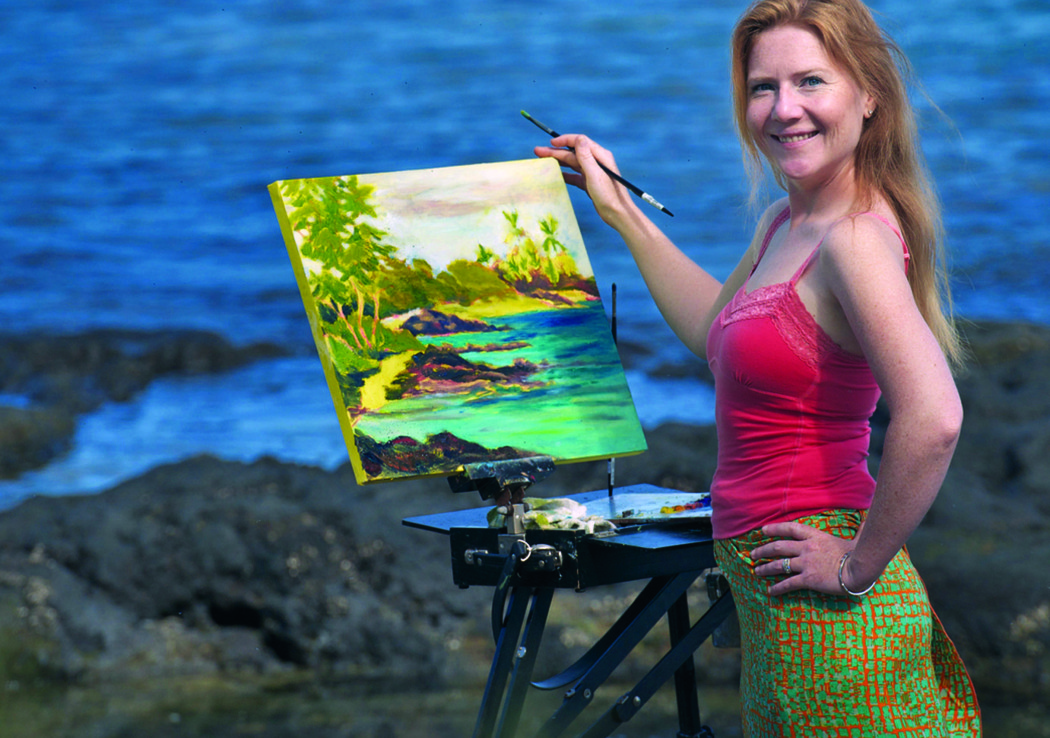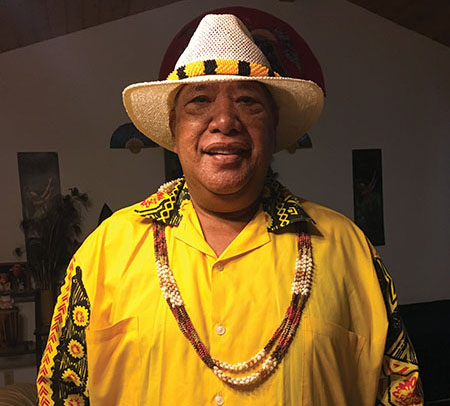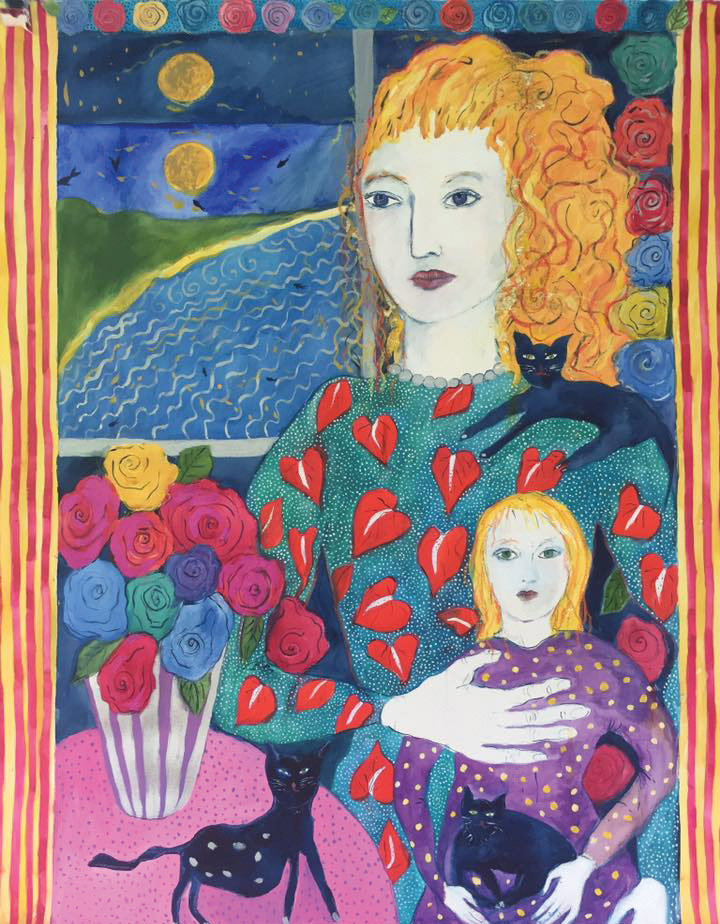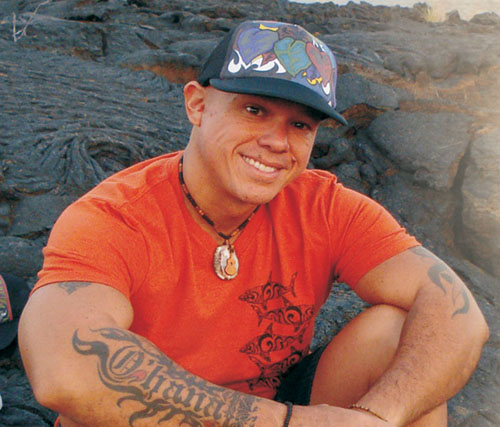
Creating Ha with Bolo: He’s “Been There, Done That,” and Made the T-Shirt
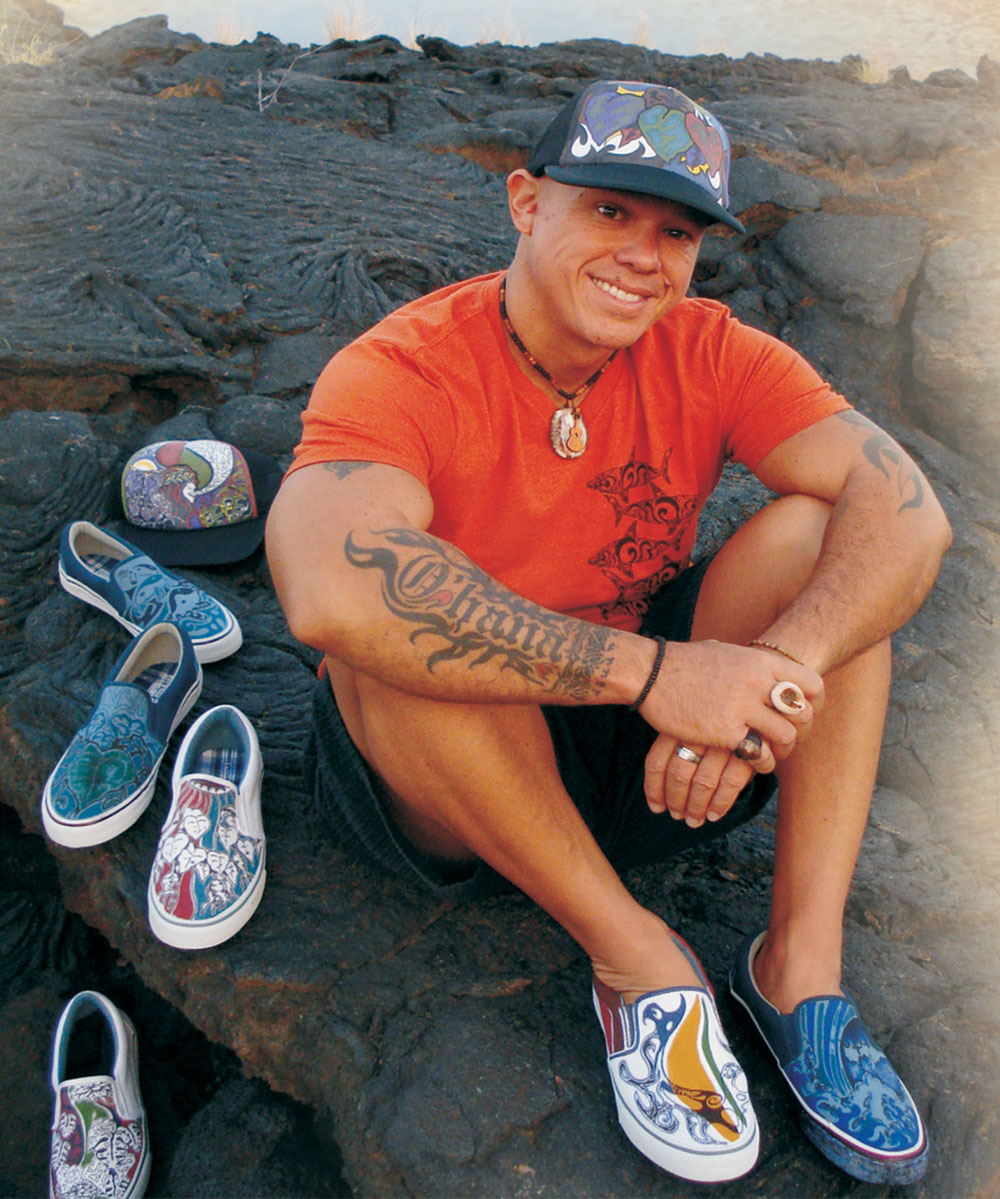
With Music Correspondent Colin John
Bolo Mikiela Rodrigues, or “Bolo” as he is best known, greets me at the gate of his family home—which also serves as his design workshop and inspirational hale—with a friendly smile and an affable, ”Howzit?” I see a hip-looking ‘61 Ford Falcon wagon and an older Toyota truck nearby—both sun-bleached, sturdy cool, green-oriented, unpretentious and completely operational, much like the subject of this article.
Bolo is a modern day Renaissance Man, with simultaneous passions for art, music, community, green-oriented clothing, recycling, the ‘aina, ‘ohana, spirituality, children’s education, design and the desire to share these things with the world.
An accomplished Big Island musician and businessman, Bolo has “been there, done that” (and designed those t-shirts). He’s rubbed elbows with Hollywood stars, written Grammy and Hoku-nominated songs and gone through difficult times both in his home state of Hawai‘i and in the uncertain, darker world of the California rock-n-roll circus. I was struck with how his life seems to be the equivalent of an elder, yet wiser bluesman. He’s dealt with love problems, drug abuse and alienation and always come through as wiser, stronger and gratefully aware—a survivor, rising Phoenix-like from the ashes.
With finches providing a pleasant musical soundscape and the sun beating down on the Toyota and Ford, we sit under the shade of the carport and talk story.
CJ: Folks might have seen you around the island with one of your trademarks—a uke and guitar played together at the same time. Can you tell our readers how it happened and do you have a name for this?
It is called Ukeitar—a funny word that makes people laugh and kind of describes the two instruments together. My love for both is strong. As there are always two sides to everything—yin and yang, balance and harmony—so too these instruments. One day, after being fed up with the band thing, I was staring at my guitar and uke in their separate stands, and wishing that they could become one instrument. It was a puzzle that fit perfectly and is held together by Velcro, patent pending (laugh). Hardest part of playing without stopping is timing. After three years it’s second nature, but not without a lot of practice.
CJ: That instrument might be a metaphor for your life, balancing art and music, ‘‘ukulele and guitar, island music to heavy metal and back again. How did it all start?
Back at Kealakehe Elementary School our music class had ‘ukulele studies, which I did not excel at because I often created my own music rather than what was academic. Inventing or composing music came relatively easy for me, but it was frowned upon, as was my art, where I would paint trees purple and dogs and cats silver and gold.
I kept practicing the ‘ukulele, and around 8 years old, I won a couple of talent shows. My mom really wanted me to learn guitar, especially slack key style. So she took me to my uncle where I learned a few songs and some different tunings. My mom’s Hawaiian, with family ties to Kekaha Kai or Mahaiula. I’m also part Puerto Rican, from my dad’s side.
CJ: You also have a business in screen printing—BoloInk. How did that interest develop?

In art class senior year we learned about T-shirt printing and, when I starting doing custom designs for the other students and making money at it, I knew that was one of the things I wanted to do as a business.
As soon as I graduated high school I moved to Maui and interned with a guy I met who had a T-shirt company. There I designed a line of T-shirts called “Big Boyz.” The owner took these designs to a couple of stores and they began selling a lot! But I never saw any money even though it had been promised. I would see people wearing these all over and one day I went into one of the stores, introduced myself to the owner as the creator of Big Boyz designs and shared my story. He advised me to start my own business and helped me hook up with a buyer at a big retail store on O‘ahu.
Flying to the big city for a meeting on my own, straight out of high school, was nerve-wracking but also exciting, and I had my first order of 2,000 shirts. A very big first order! Then I had to figure out how to print them. I moved back to Kona and my ‘ohana pulled together to raise the funds. I bought a “how to screen-print” book and the equipment, while working out of the garage at home.
As the orders became bigger, I needed a shop so I moved to the industrial area. My company was growing fast, but at the same time personal relationship problems were happening. The combination was very hard at that time. My relationship was over and my business was going too. I was angry and searching.
This is when I felt music calling me, my only friend who really understood, never judged and was there day or night. I love all types of music, not only from instruments, but from the music of birds, waves, wind and nature. This is when I started to explore the world of angst through heavy metal music. Teaching myself how to play from books about fast-picking, heavy metal, heavy crunching and distorting sounds, I bought my first electric guitar. I was on my way to becoming the next Van Halen, just a Puerto Rican-Hawaiian version.
CJ: That’s a big change from the laid-back, island style. Then you joined a band?
I joined a band called Ikaika with far more experienced players. I was just learning how to play electric guitar in a reggae-rock-fusion style but the band actually broke up a few times because my guitar playing sucked. I came from a local style of thought process called Rush ‘um and Give ‘um. You see I didn’t and still really don’t know music theory and chords.
Eventually I got better and I wanted more of everything—the limelight, MTV, Hollywood, glamour, bling, everything superficial. So I moved to California (laugh). By this time, my business was done and all I wanted to do was get away. My sister lived in Sacramento so I figured that was as good a place to start as any. As soon as I got off the plane I wanted to start playing music. I asked my brother-in-law where I could go and he took me to a hole-in-the-wall place to jam. I was asked to join a blues band called Desperados. I felt desperate at the time, so this seemed to fit. Playing with them I learned a lot, not only songs by Jimi Hendrix and Stevie Ray Vaughan but branching out with my own songwriting and style.
CJ: So you went from the blues to heavy music like Rage Against the Machine and Papa Roach. That’s quite a transition! Did your band do the LA grind?
Yes, I started to learn that most of what I had heard about the music industry was true. Back stabbing, two-faced etc. It was truly a learning experience. At the same time back in Hawai‘i my mom was really sick and I began to question what I had been chasing for eight years. I didn’t feel like the music I was playing was right for me and that my ‘ohana and Hawai‘i were calling me back.
CJ: That takes courage and sense to walk away from a negative situation. Is that when you went back to screen printing?
Yes, I moved to Hilo, where I had some family and friends and I went back to screen printing. I asked an uncle to be my partner and we started a shop called BoloInk. Business came almost right away, but I was missing music. One day at a coffee shop called Kope Kope, I asked the owner about doing T-shirts as well as music. I got both jobs.
CJ: I understand that our mutual friend, Mati Laino, helped introduce you to some Hilo musicians, including Uncle Skippy. Were you reintroducing yourself to Hawaiian music at this time and where were you playing?
I did T-shirts for the band MoeMoeA, I met Mati, then the rest of the boys. I came back to my roots as part Hawaiian, part Puerto Rican, and began getting closer to becoming the whole me.
CJ: After your mother’s passing, you moved back to Kona and met some other inspiring people. Can you tell the readers about your experiences with them and how this led to your vision of Creating Ha?
After a couple of years back in Hawai‘i, my true sound started to evolve. I wanted to find a connection to the next level of musical artistry, fusing everything I learned previously till now and to share it with people. I stopped worrying about superficial things and began to make a change inside.
I met a slack key, finger-style player by the name of Chris Yeaton. He’s my age and has a company called Woodsong acoustics, a group of exceptional guitarists all across the country. I had sent him a demo of my fusion slack key and he called me. We became friends as well as fellow musicians. He asked if I wanted to go on tour and off we went! It became another great learning experience and we did numerous shows from Washington and Oregon to Northern California with a few Grammy-winning guitarists. I was experiencing musical growth as well as spiritual growth. Another one who inspired me was Jason Scott Lee. We had a chance to play at his theater and talk story and have been good friends ever since.
I really don’t think that there are any chance meetings. This proved even truer in meeting Andy Rising, a classically trained cellist at a kanikapila jam with Chris. I started a song and Andy joined in, improvising and merging classical and slack key. It was so beautiful that I wanted to share his talent on Creating Ha, an instrumental CD with all original compositions about how I felt coming back home, and reflecting on areas around the island.
I was also inspired to become involved in charities and non-profit organizations such as Relay for Life, Make a Wish Foundation, LifeCare and Recycle Hawai‘i. I have been involved in a program called The Artist and the Environment for about two years now. In conjunction with Recycle Hawai‘i, “Creating Ha,” the play, will have its first showing at the Palace Theatre in Hilo on April 20th. I believe the keiki are our future and not just a cliché, which is why I love this program.
At the Ka‘u Coffee Festival last year, I was part of a song writers workshop sponsored by Daniel Ho. To spawn our creativity, the group was taken to a few places courtesy of Julia Neil at the Plantation House in Ka‘u and The Nature Conservancy. A place called Ka‘iholena caught my soul and as soon as I got back to the plantation, I needed to write. Everyone gathered around me to listen and slowly, as if lighting a match to kindling, a fire of inspiration became a song. It was the first I had written with anyone, much less nine other songwriters. It was a completely awesome experience and song. So much so that Daniel put it on this year’s Grammy nominated CD He Nani. The song is called “Ka‘iholena.“
CJ: Can you elaborate on Recycle Hawai’i and the character KOA that you have created for children?
KOA-Kids of Aloha–is an ambassador character I created for Recycle Hawai‘i that offers eco-minded news for their newsletter, coloring and comic books that deal with social and environmental issues as a learning tool.
CJ: What plans do you have for the rest of 2010 and for the future?
I am working on a screen play about my family, Kaelemakule; and “Creating Ha,” the play, with orchestrations. Also KOA for Recycle Hawaii and a series of learning tools for the keiki, plus Creating Ha, an organic clothing line. A new CD of Latin guitar and Ukeitar, as well as a new CD of singer-songwriter music is in the works. And just being involved with the positive projects and kokua, whenever possible moving forward, imua. I try to be a vessel for good works that nature can flow through, using whatever talents I can offer. Mahalo Ke Akua.
The dark days are long gone, remembered and wisely avoided, replaced with a bright, focused vision for himself and the world that he graciously lives in. Bolo has come full circle, back to his roots, with an inner strength and desire to share, “Creating Ha.” ❖
For further information about Bolo’s music, art, CD’s and clothing, visit www.creatingha.com.
Email Colin John at transpacificblues@yahoo.com.
